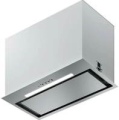Motor power
The power of the hood at maximum speed.
The more powerful the device, the more performant it is, usually. However, there is no rigid dependence here, and hoods of the same power may differ in actual performance. So it is worth evaluating power consumption in terms of power first of all: the lower this indicator, the more economical the device. And when evaluating performance, you need to look not so much at power as at the directly claimed flow of the air (see below).
Flow of air (motor)
The maximum flow of air or motor flow of air indicates the theoretical capability of the device. This parameter of the hood (motor) is measured during idle operation. By connecting the duct and working in the appropriate mode of extraction, the flow of air will be lower. However, high-performance motors will also give a high flow of air in extraction mode.
Flow of air (extraction)
The performance of the hood in extraction mode at maximum speed shows the real possibilities for air purification. Since this parameter is several times less than the motor performance (maximum performance), not all manufacturers indicate this value, trying to present large and beautiful numbers. A similar situation can be observed among other devices. For example, in vacuum cleaners, the total power is many times greater than the suction power; in acoustics, mediocre brands prefer to list peak power instead of nominal power. Therefore, motor performance and extraction performance can not be compared. However, high-performance motors will also give high performance in extraction mode. And it may well be that the conditional Bosch with an extraction performance of 300 m³/h will be better than another hood with a maximum motor performance of 500 m³/h.
Flow of air (intensive mode)
Extraction flow of the air when using intensive mode. This mode is used in case of emergency on the stove, such as burnt food, spilt liquid, etc., which give off a lot of smoke and an extremely unpleasant smell. In turn, the intensive mode forces the hood to run at maximum speed, thereby increasing its performance even more (compared to performance at maximum speed). However, this function is activated for a short time (so the motor does not burn out). Therefore this mode is not considered standard, and it will not be possible to use it in everyday cooking.
Lighting
Lighting method provided as standard in the hood.
— Incandescent lamp. The simplest and most affordable of modern lighting sources. The main advantage of incandescent lamps is their low cost. In addition, they give a fairly eye-pleasing light in warm colours. On the other hand, such lamps are the most energy-intensive. Besides, they get very hot during operation.
— Halogen lamp. An improved version of the incandescent lamps described above. They are distinguished by higher brightness at lower power consumption while also having a spectrum of luminescence that is pleasing to the eye. At the same time, halogen lamps are still inferior in terms of efficiency to fluorescent and LED lamps.
— Fluorescent lamp. Also known as "fluorescent light bulbs" or "energy-saving light bulbs". One of the advantages of such lamps is just low power consumption — many times lower than that of incandescent lamps (although higher than that of LEDs). The light from fluorescent lamps is white, rather cold; this can be both an advantage and a disadvantage, depending on personal preferences and interior features. But of the unambiguous shortcomings, it is worth noting that most of these lamps contain mercury vapour in the flask; because of this, failed light bulbs must be disposed of according to special rules, and a broken lamp can become a source of health problems.
—
Light-emitting diodes (LED). The most advanced of mod
...ern lighting sources. LEDs are highly energy-efficient. They are more economical than incandescent lamps, and they practically do not heat up during operation. The light from such sources is neutral white, which is quite suitable for most cases. The disadvantage of LEDs is a rather high price.
Note that many modern hoods allow you to replace a regular light source — for example, a halogen lamp can be changed to a fluorescent or LED lamp with the same base.Country of origin
The country in which this or that model is manufactured. Even though most of the capacities are concentrated in China, European factories for the production of household appliances have not disappeared. And certain models can be produced at them. In general, such a division into a Chinese or European factory should not particularly affect the quality of products, but the stereotype of a reliable European assembly is still present. However, it is possible that the model may have a country of manufacture, for example, Poland, and in the store under the same article, you will meet China.

